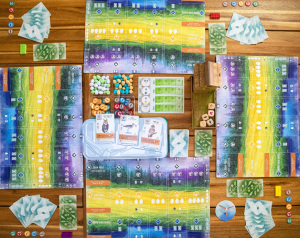Creativity is few and far between among working adults. We’re too wrapped up in whatever our last business meeting was or that project that needs to be finished by next week. But really step back and think: When was the last time you engaged your imagination and connected with the people around you? More importantly, when was the last time you spent time with anyone without any electronics? No television, no video games and no phones to interrupt.
For me, board games are how I step away from the trials and tribulations of being a stressed-out undergraduate student, and the first one I ever played (aside from childhood classics like Candy Land and Chutes and Ladders) was Wingspan.
Released in 2019 by Stonemaier Games, Wingspan has since climbed to the top of many must-buy board game lists—and for good reason. Up to five players get to leave their day jobs behind and become ornithologists working to attract the best birds to their aviaries. The game is played over the course of four rounds, during which players collect food tokens, lay eggs, draw bird cards and add birds to their habitats. Wingspan is an engine-building game, meaning the “aviaries” (card systems) will become more complex and powerful each turn.
If your Monopoly games typically end in someone flipping the board, Wingspan may be the perfect mix of fierce competition and independent play. In each round, the ornithologists try to complete a given task specific to that round. The tasks are randomly determined at the beginning of the game and are something you can plan for in rounds prior. Sometimes, it’s having the most eggs in one nest type; other times, it’s having the most birds in a certain habitat. The better you do than your competitors, the more points you get.
If this seems too competitive for you, there’s also an independent scoring option for the round-by-round tasks. Instead of fighting against the other players, you’ll try just to meet a goal to get points. Players can earn additional points by completing solo bonus tasks collected throughout the game—these are tallied at the end while calculating final scores.

Perhaps the most striking aspect of Wingspan is the art. Each player receives their own player mats, beautifully decorated with three habitats for their birds to reside in: the forest, desert and water (i.e. lakes, oceans, swamps). Throughout the game, players will choose from over 170 unique bird cards to play in their aviaries. Each card features an accurate drawing of the bird, the common and scientific names, the card’s in-game ability and—my favorite part—a map denoting where the bird is native to and a fun fact about the species.
The game setup also uses a cardboard “bird feeder” to roll the food supply dice in. While it isn’t essential to the game, it certainly adds to the whimsy. Even better, the bird feeder fits in the game box without having to be fully deconstructed, so you’ll actually use it.
For those just dipping their toes into the tabletop community, board games are often classified by weight. The “heaviness” of a game is determined by a variety of factors, primarily difficulty in learning, interpretation and execution. Wingspan is classified as a medium-weight game, although I feel it’s truly as beginner-friendly as you can get. As the game progresses, each turn requires more steps, but the wooden action cubes make what would be complex moves intuitive. This is where other well-known games like Root fall short: the phases become too confusing, especially when you have large groups or new players.
If you are a beginner just looking for a new hobby, Wingspan also has a single-player mode where you can hone your strategy and planning skills. The “automa” cards simulate an opponent. Take your turns as usual, then flip the top card from the automa deck to determine its move. More specifics can be found in the booklet with every base game. The game is also a great way to find others in the board game community—the game developers even have a Wingspan Facebook group.
Most importantly, I think the marker of the well-made board game is when different strategies—not just one—can be successful, and Wingspan accomplishes just that. In my own gameplay, I start working on the third and fourth round goals at the beginning of the game. I tend to pick point-heavy, longer bonus goals that give me an edge over my opponent. My partner, however, goes for quick points as many times as possible. He plays aggressively, filling his aviary with eggs and (low point) birds as quickly as possible. Needless to say, it’s always a toss-up who wins—which makes playing all the better.
The only place Wingspan fails is in two-player games—they just feel too rushed. There simply isn’t enough time to benefit from other players’ cards like you would in a three-or-more-player game. Just as there is a less competitive side on the goal tracker, there should be an additional mat with five rounds just for lower-player sessions. Perhaps this could be a “house rules” adaptation to your own gameplay.
The game’s only other flaw is that it’s absolutely addictive. Fans can broaden the Wingspan world with expansions including Europe and Oceania or even tap into the fantasy realm with Wyrmspan, a dragon-variant of the game. Do you have what it takes to be the world’s best ornithologist?








